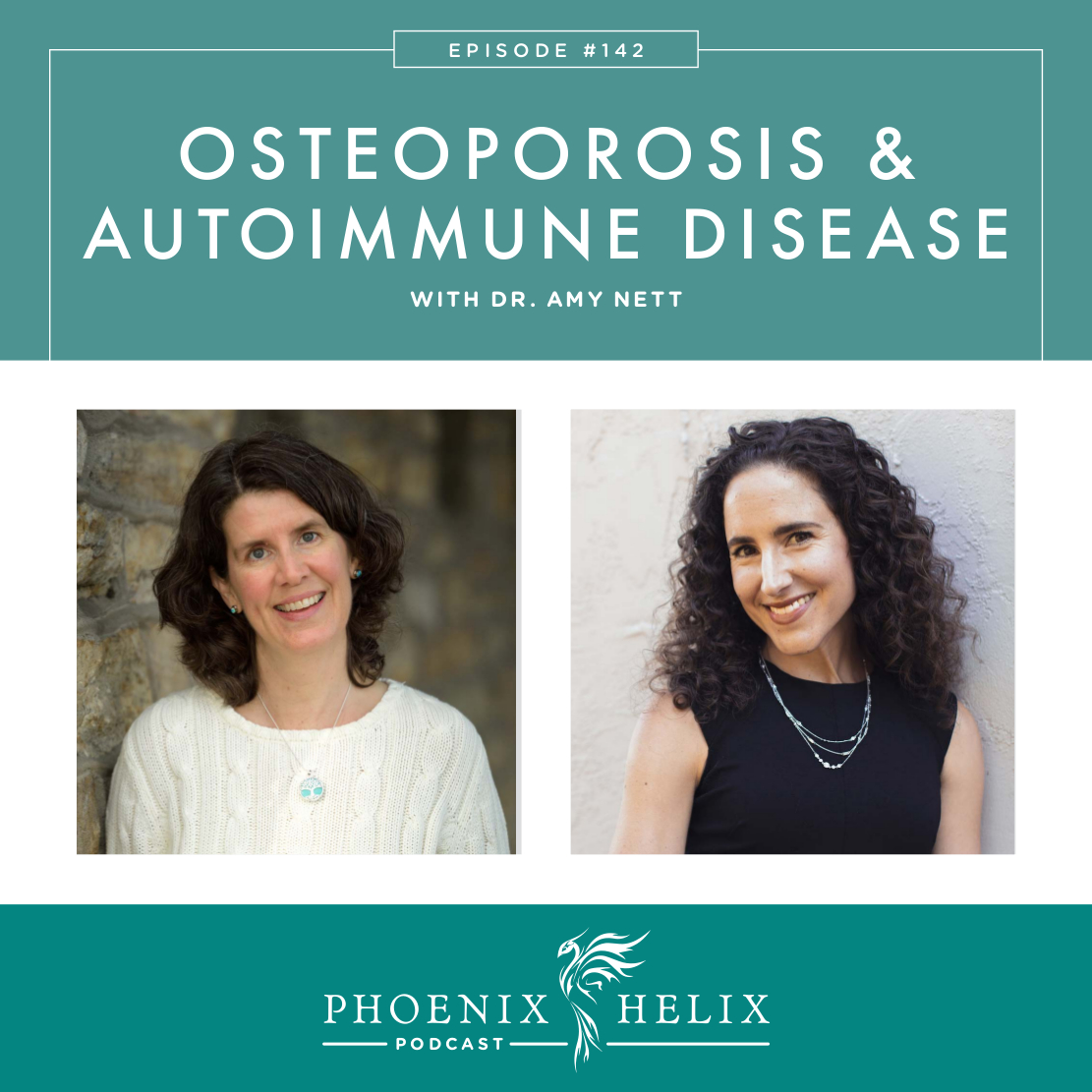
Brittle Bones
Osteoporosis is a condition where the bones become weak and brittle, and it’s usually associated with aging. But it turns out that autoimmune disease increases our risk of getting this condition at a younger age. In this episode, we talk about why this is true and what we can do to prevent and reverse it. What tests are available? What treatments are helpful? What self-care steps are most effective for maintaining our bone health? My guest is functional medicine physician, Dr. Amy Nett. She answers these questions and more.
Listen to the Show
- Subscribe to my podcast through your favorite podcast app: iTunes, Stitcher, Google, TuneIn, Spotify, Amazon, etc.
- You can also listen to the episode right here through the player below, and if you subscribe to my newsletter you’ll get notified of future episodes.
Podcast: Play in new window | Download
Show Notes
- Intro (0:00)
- Thank You to Our Podcast Sponsor: Autoimmune Strong (1:36)
- One of the most important factors in preventing osteoporosis is exercise. But what if your inflammation is so high that exercise seems to hurt instead of help? This program is for you! It’s specifically designed for people with exercise intolerance, to help you slowly and safely exercise in a way that builds strength without increasing inflammation.
- Autoimmune Strong is the only online exercise program designed for people with autoimmune disease, by a personal trainer who has autoimmune disease herself.
- Membership gives you access to videos that are designed for all body types – even people with severe joint pain or limitations getting up and down off the floor. The videos are short and easy to follow. They slowly progress in intensity and teach you how to find the level of exercise that’s safe for you. The program focuses on strength, flexibility, and cardio fitness. In addition to the videos, membership gives you access to a supportive online community and a monthly Q&A call with founder and personal trainer, Andrea Wool.
- Listen to my interview with Andrea to learn all about exercise intolerance and why it’s a common side effect of autoimmune disease.
- Join Autoimmune Strong and use the code PHOENIX for 10% off your first month.
- Meet Dr. Amy Nett (3:34)
- Dr. Nett originally trained as a conventional MD, but during training her health started to suffer. She thought it was simply the sleep deprivation common to medical school, but as her symptoms worsened she started researching other solutions. She discovered the ancestral lifestyle and switched from a low-fat vegetarian diet to a nutrient-dense paleo diet instead. She felt exponentially better. This new knowledge changed the trajectory of her career. She pursued dual certifications in both functional and integrative medicine and uses this holistic approach in her clinical practice.
- Prior podcast interviews with Dr. Nett:
- Defining Osteoporosis vs. Osteopenia (5:58)
- Osteoporosis = weak and porous bones. It’s a disease that involves low bone mineral density combined with compromised bone integrity, making the bones more susceptible to fracture. This is the concern. In the elderly, a significant number of hip fractures result in death within the next year.
- Osteopenia = low bone mineral density without the fracture risk. Dr. Nett doesn’t like the label, because it’s often used as a reason to prescribe medication before medication is needed. Instead, this is great information to inspire lifestyle changes that can prevent the progression to osteoporosis.
- Both conditions are reversible, depending on age, severity, and underlying conditions. Mild or borderline osteoporosis can often be reversed to simple osteopenia. Most importantly, with either condition, you can take steps to decrease fracture risk.
- The Biology of Bones (13:12)
- We think of our bones as solid and static, but our skeletal system is dynamic, and our bones are always remodeling in response to our internal and external environments.
- There are two main bone cells: osteoclasts and osteoblasts. Osteoclasts break down bone, which sounds bad but this resorption is necessary to bone health. Osteoblasts build bone. Healthy bones require a balance between these cell activities. If osteoclast activity is higher than osteoblast activity, the result is reduced bone mineral density which can lead to osteoporosis.
- Resource: Animated Video of Bone Remodeling.
- What Increases Your Risk of Developing Osteoporosis? (10:32 & 16:40)
- Non-modifiable risk factors:
- Age (peak bone mass is reached at age 30 and decreases from there).
- Gender (women are at higher risk than men).
- Petite frame (small bones have lower reserves).
- Genetics (people of Caucasian and Asian descent are at higher risk).
- 3 biggest risk factors which we can address:
- Health conditions which increase risk:
- IBD, including Crohn’s disease and ulcerative colitis.
- Rheumatoid arthritis.
- Untreated hypothyroidism or hyperthyroidism.
- Diabetes.
- Chronic depression.
- Eating disorders.
- PCOS
- Endometriosis.
- Early menopause.
- Nutritional deficiencies
- Lifestyle factors which increase risk:
- Too much or too little exercise.
- Diets high in sugar, salt, soft drinks, and processed foods.
- Diets that are too restrictive, even if the foods you eat are healthy.
- Too much caffeine (Dr. Nett recommends no more than 1-2 cups per day).
- Too much alcohol (Dr. Nett recommends no more than 2 servings per week)
- Cigarette smoking.
- Medications which increase risk:
- Sometimes these medications are needed. The goal is the lowest possible dose for the shortest possible time. The risk increases with long-term use.
- Proton pump inhibitors (Prilosec, Nexium, etc.)
- Corticosteroids (prednisone, hydrocortisone, etc.)
- SSRI’s (Prozac, Zoloft, etc.)
- Non-modifiable risk factors:
- Hormones and Bone Health (22:51)
- Our bones actually have progesterone and estrogen receptors. When women go through menopause, that is the steepest decline in bone loss – up to 20%. For this reason, Dr. Nett recommends bio-identical hormone replacement therapy (BHRT).
- The thyroid also impacts bone health, and both hyperthyroidism and hypothyroidism increase risk.
- Lastly, there are hormones involved with blood sugar regulation which impact bone health as well. When we eat too much sugar (including natural sugars), it puts the body on a blood sugar rollercoaster. This releases excess cortisol (increasing inflammation), and insulin (which decreases the level of other hormones that support bone health).
- Resources:
- Autoimmune Disease as a Risk Factor for Osteoporosis (27:54)
- Many common traits of autoimmune disease are also risk factors for osteoporosis.
- Chronic inflammation increases the production of osteoclasts (the cells that break down bones) without increasing the production of osteoblasts (which are needed to rebuild bone).
- Pain and disability can restrict movement and make exercise more challenging.
- Digestive issues increase the likelihood of nutrient deficiences and food intolerances.
- And some medications like corticosteroids (used to decrease inflammation) also increase osteoporosis risk.
- However, if your autoimmune disease is well-managed, that decreases your risk dramatically. Everything we do to support autoimmune health promotes bone health as well.
- Thank You to Our Podcast Sponsor: Paleo on the Go (32:42)
- A frozen meal delivery service, 100% of their menu is compliant with the elimination phase of the paleo autoimmune protocol (AIP). They have over 5o items, including entrees, side dishes, broth, AIP-friendly bacon, and desserts.
- Use the code PHOENIX for 10% off your first order.
- Osteoporosis Testing (34:18)
- DXA Scan: measures bone density, but it doesn’t measure the quality, strength, or resilience of the bone. Dr. Nett uses this tool in combination with others. (Note: she doesn’t recommend medication based on a single DXA Scan.) This scan provides 2 scores. The Z score compares your bone density to the average of people of the same age and gender. However, the T score is what’s used for diagnosis; it compares your bone density to the average 26-29 year old of the same gender. A score of -2.5 or lower indicates osteoporosis. -1.5 or lower indicates osteopenia. Insurance sometimes covers this scan, but you need to check with your provider.
- Free tools that assess fracture risk: The FRAX and the FORE. They’re both questionnaires that look at common risk factors.
- Telopeptide tests: these track osteoclast activity and can be tested in the blood or urine. This is helpful for measuring whether or not a treatment is working. High markers show increased risk of fracture. Decreasing markers show decreasing risk.
- Conventional Medical Treatment for Osteoporosis & Osteopenia (41:21)
- They are often treated the same – with high-dose calcium supplementation and/or prescription medication.
- Anti-resorptive medications (like Fosamax) work by inhibiting osteoclast activity. They’re a treatment – not a cure, and their benefits often go away after stopping the medication. The problem is that serious rare side effects limit their use. Even conventional MD’s don’t prescribe them for more than 5 years. Dr. Nett recommends a maximum of 2 years. These rare side effects include low-trauma hip fractures and jaw necrosis. That said, in some circumstances, for a limited time, Dr. Nett might still prescribe this medication as a bridge measure alongside complementary treatments to support bone health (diet, supplementation, and exercise). For example, if someone has severe osteoporosis with a T-score of -4 or lower, and a previous osteoporosis-related fracture, the benefit might outweigh the risk.
- Isolated high-dose calcium supplementation comes with risks also. Not only is the research uncertain whether it even reduces the risk of fracture, it also increases the risk of heart disease. Excess calcium in the bloodstream can be deposited on the artery walls.
- Dr. Nett’s Supplement Recommendations (49:35)
- Supplement needs vary between individuals. These are general guidelines. If you have osteoporosis or osteopenia, it’s best to work with a practitioner.
- Try to get your calcium through food first. Use an app like Cronometer to track your diet. Most people need 800-1200 mg/day. The best food sources of calcium are: canned wildcaught salmon and sardines (with the bones included), goat or sheep dairy (if tolerated), certain dark leafy greens (such as collards, spinach, and kale), certain soaked & sprouted nuts if tolerated (such as almonds and hazelnuts).
- If you need to supplement with calcium, calcium MCHC is Dr. Nett’s first choice. Calcium citrate is her second choice. The body can only absorb 500 mg at a time, so if your dose is higher than that, divide into 2 doses taken at different times of day. And if you’re taking thyroid medication, wait 4 hours before taking calcium (minerals can interfere with the absorption of the thyroid hormone).
- It’s also important to include co-factors that balance calcium in the body and aid absorption. There are 3 such supplements that Dr. Nett recommends to her patients: (1) Magnesium glycinate (400-800 mg. with dinner). (2) Vitamin D3 (using lab tests for guidance on dose). (3) Vitamin K2 (150-200 mcg).
- B vitamins and boron can also play a role in bone health.
- There is a lot of supplement fraud in the market now, so Dr. Nett recommends brands that are tested by independent labs for purity and potency. Her favorite brands include Thorne Research, Vital Nutrients, Designs for Health, and Protocol for Life Balance.
- Exercise and Osteoporosis (57:08)
- Exercise intolerance is a common side effect of autoimmune disease. Physical ability will vary based on level of inflammation, so when you’re in remission you will be able to exercise more than during a flare.
- Ideally, Dr. Nett recommends a combination of cardiovascular, strength, balance, and stretching. All of these benefit health on multiple levels, including bone health. Most importantly, choose exercise that you enjoy.
- If your symptoms prevent strenuous exercise, she recommends yoga, tai chi, or pilates. This increase balance, flexibility, and proprioception, all of which help prevent falls (and the fractures that can happen with falls.)
- Sometimes with autoimmune disease all exercise feel impossible. In that case, start with the goal of simply incorporating a little more movement in your life. And remember, Autoimmune Strong is a great resource. It’s designed specifically for people in this situation. They have a free 7-day trial, and if you like the program, use the code PHOENIX for 10% off your first month.
- Functional Medicine Approach to Osteoporosis (1:02:01)
- It’s a comprehensive, whole-person approach, that looks at root causes as well as current symptoms.
- Troubleshooting areas that can impact bone health: gut health, hormone balance, and heavy metals.
- The Most Important Self-Care Step for Preventing Osteoporosis (1:06:16)
- A nutrient-dense diet, combined with daily movement.
- Outro (1:06:40)
- You can connect with Dr. Amy Nett through her website, and she is accepting new patients. She’s also created an osteoporosis resource page on her website.
- Eileen (your podcast host) is the author of multiple books, written to help people thrive with autoimmune disease. Learn more on the Books Page.
- If you like this podcast, follow or subscribe through your favorite podcast app. You can also subscribe to Eileen’s biweekly newsletter.
- Check out the entire archive of podcast episodes.
You May Also Be Interested In
Spreading the Word
If you like the podcast, please leave a positive review in iTunes. It would mean the world to me, and also helps others find the podcast. Here are some quick instructions using your iPhone:
- If you are already subscribed to my podcast: (1) Click the purple podcast icon. (2) At the bottom of the screen, click Library. (3) At the top of the screen, click Shows. (4) Click the Phoenix Helix podcast image. (5) Scroll down the page, and you’ll see Ratings and Reviews. Scroll down a little bit more and click on Write a Review. This will bring up the review screen. Tap 5 stars (if you love the podcast), and then click in the title box, and it will bring up the keyboard. Enter a title and short review. (6) Click Send in the upper right corner. (7) Thank you! Positive reviews give the podcast a higher search ranking in iTunes, helping people find it and letting them know it’s a quality podcast and worth their time to listen.
- If you haven’t subscribed to my podcast: (1) Click the purple podcast icon. (2) In the lower right corner, click the magnifying class. (3) Type Phoenix Helix in the search box. (4) Click the podcast cover in the Show list. (5) If you’d like to subscribe, click the + sign at the top of the screen. (6) To write a review, scroll down the page, and you’ll see Ratings and Reviews. Scroll down a little bit more and click on Write a Review. This will bring up the review screen. Tap 5 stars (if you love the podcast), and then click in the title box, and it will bring up the keyboard. Enter a title and short review. (7) Click Send in the upper right corner. (8) Thank you! Positive reviews give the podcast a higher search ranking in iTunes, helping people find it and letting them know it’s a quality podcast and worth their time to listen.

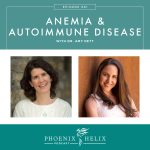
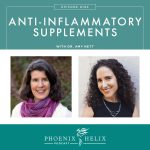
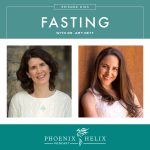

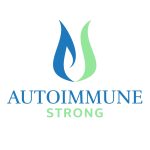
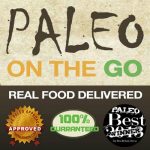

This info. in this program is amazing-thank you SO much!! I have both osterprosis and estopenia from a total hystrectory at age 36 (and perhaps the endometriosis itself I had in my 20’s.) I “tried” Fosmax and fortunatlely, I had problems with them (flu-like symptoms) so I went off of them after one week. Calcium supplements caused serious GERD. So I take none. I have worked very hard all of my life on my weight bearing exercise on behalf of my bones (and my heart); running/walking daily for 10 years in my 20’s, ten years of aerobic dancing in my 30’s, backpacking, swimming and power walking, biking in my 40’s, then back to yoga for 12 more years in my 50’s and 60’s (as well as walking my dog up to three hours per day in my 60’s) and still my bones detiorated… At age 67 I began to take Bio-TE bio-identical hormone implants with the goal of restructuring my bones. Within one year my dexa scan began to show improvements in my bones. SUCCESS at last! I will continue my 3-4 days per week exercise protocol, my nutrient rich AIP diet, my bloodwork determined supplements as well as the bio-identical hormones. I hope that my story might help other women!
Thanks for sharing, Donna. Wishing you continued health!